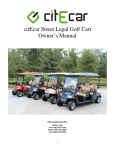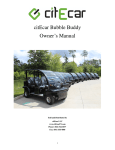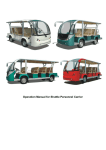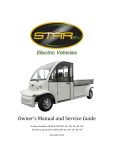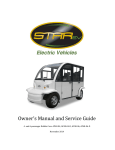Download citEcar Street Legal Golf Cart Owner`s manual
Transcript
citEcar Street Legal Golf Cart
Owner’s Manual
Sold and Distributed by
citEcar LLC
www.citEcarEV.com
Phone: (866) 542-8677
Fax: (352) 376-6810
Table of Contents
Introduction ....................................................................................................2
Operating System ...........................................................................................4
Start Up Procedure .........................................................................................4
Important Rules to Remember .......................................................................5
Disclaimer ......................................................................................................5
Maintenance ...................................................................................................6
Battery ....................................6
Charger ...................................6
Motor......................................7
Speed Controller ....................8-9
Brake System .........................9
Lubrication .............................10
Break-In Procedure ................10
General Maintenance .............10
Warranty Information ....................................................................................11
Unit Information ............................................................................................12
Notes ..............................................................................................................13
2
Introduction
citEcarEV, LLC is pleased to offer its line of low speed vehicles. These vehicles are
perfect for driving around campgrounds, universities, neighborhoods, airports, and more!
The street legal golf carts are offered in two, four, and six passenger models.
Why would I want an LSV?
It's logical! Sixty five percent of U.S. families own a second car, yet over 50 percent of
urban trips last less than ten minutes perfect for LSVs. Eighty percent of all trips are
within 10 miles or less in a traditional automobile resulting in cold running motors that
translate into excessive engine wear and more pollutants. LSVs are the right "tool" for
most of our transportation jobs.
Commercial Vehicles
citEcarEV LLC also offers several commercial vehicles for sale. Some include:
•Delivery Buddy - A two passenger vehicle, with an extra large insulated cargo box on
the back of the unit. It is perfect for local mechanics and food delivery companies.
•Utility Buddy - A two passenger vehicle with a rear truck bed.
•Security Buddy - A four passenger vehicle with lights and a siren. Perfect for malls,
hotels, colleges, airports, and more!
•Transport Buddy - The transport buddies come in three different sizes: 9 Passenger, 12
Passenger, and 15 Passenger.
3
Operating System
Ignition Key Switch - Insert the key and turn it clockwise to power on the lights, horn, and
control system.
Accelerator Pedal - This controls the driving speed. Step on slowly to accelerate, push all the
way to the floor for full power. Release the pedal partially to reduce speed. Releasing the pedal
completely will cut power to the engine and the vehicle will come to a stop.
Brake Pedal - Causes the vehicle to decelerate and stop.
Parking Brake - Apply when parked.
Light Switch / Turn Signal – Turn on for headlights, push lever UP for RIGHT turn signal, and
DOWN for LEFT turn signal.
Windshield Wiper - Push switch to turn windshield wipers ON, back DOWN for OFF.
Voltage Meter - This meter indicates the current power supply of battery. This can be found on
the digital dashboard.
Start Up Procedure
1) Turn the key clockwise to the ON position
2) Switch the vehicle into forward or reverse.
3) Release the parking brake.
4) Step on the accelerator pedal to begin moving.
Important Note: Your low speed vehicle will not run if you press the accelerator pedal
before turning the key to the ON position.
4
Important Rules to Remember
Before operating your low speed vehicle, you should familiarize yourself with your local
laws. It is always important to remember the following rules:
1) Check with your local DMV for any laws that relate to using a low speed vehicle in
your city.
2) Do not ever load more weight onto your vehicle than it is rated for. Doing so can
damage the motor and shorten the life of the batteries. Overloading can also cause the
vehicle to become unstable, resulting in a loss of control.
3) Only let drivers that are qualified and have a drivers license operate this vehicle.
4) Be aware of faster vehicles on the road. Do not attempt to pass any vehicles.
5) This vehicle is not meant for large hills. Do not try to force it up a hill if it does not
have the power to drive up itself.
6) Make sure you slow down the vehicle when going down a hill or making a turn. Do
not attempt to do either maneuver at full speed.
7) All passengers should be seated when the vehicle is in motion. Ensure that all
passengers are using their seatbelts before the vehicle is driven.
Disclaimer
The end user is responsible to know and follow local laws pertaining to using your
Bubble Buddy on public roadways. Please adhere to any and all Department of Motor
Vehicles as well as required insurance requirements in your area. CitEcarEV, LLC does
not claim to know every requirement posted by every State and makes no guarantees that
every state has passed laws pertaining to their use on public roadways. The best source
for this information is your local state agency or your local dealer of our Bubble Buddies
from whom you purchased the product.
5
Battery Information
The battery bolts, wiring, and surface should always be kept dry and clean. To clean your
battery, use a damp cloth.
Always avoid letting water run over the batteries and onto the electrical wiring.
Check the battery connections regularly for damaged poles or loose connections.
Never store anything on top of the batteries. Also do not ever rewire or disconnect the
batteries.
We recommend that you charge the batteries after each use. Keeping the batteries at a full
charge as much as possible will extend their lives.
Regularly check the water levels of the batteries. Add distilled water when needed. The
water level should be at the max line when charged. After adding distilled water, charge
for 1 hour.
Do not let dirt or other impurities into the battery water.
When possible, do not allow the batteries to become completely discharged. This will
shorten the life of the batteries.
If the vehicle has not been used for a long time, first check the water level, and then
recharge the batteries.
Park the vehicle in a well ventilated or open area when charging.
When the batteries will no longer hold a charge for an extended time, it is time to replace
them. A replacement battery should be of the same type and voltage. It is always
recommended that you have a service center perform the battery change.
Charger
The battery charger can be plugged into a standard 110v wall outlet. You will want to use
a circuit that has a 20amp breaker for EACH plug. To recharge your low speed vehicle,
please follow the following steps:
1) Turn the key to the OFF position
2) Plug the charger into the wall, and then into the vehicle
3) Turn the charger to the ON position
When the indicator light shows FULL, the charger will shut itself off. Please leave the
vehicle plugged in when not in use.
WARNING: Do not ever attempt to disassemble the charger. Do not ever let it get wet.
6
Motor
Always operate this vehicle in temperatures between
°F and 104°F.
Keep combustible materials away from the batteries and the motor.
On a regular basis, it is suggested that the owner brushes away dirt and dust from the
motor housing. This will allow the motor to stay properly ventilated.
Troubleshooting Guide
7
Speed Controller
The controllers used in our units are made in the United States by Curtis Controllers. The
controller runs the speed, torque, smooth braking and efficiency without noise. All
contacts should be checked for obstructions and should always be kept clean. You can
clean the contacts with a brush or with high pressure air.
Troubleshooting Guide
The controller has a red light trouble indicator. The number of time the light flashes
indicates what the problem is.
8
Brake System
To do a system check, step down on the brake pedal and measure the distance between
the pedal and the front wall. The minimum gap should be no less than 1.96 inches. The
gaps between the brake pads are self adjusting. The parking brake should be used when
the vehicle is not in motion. Depress the parking brake by stepping on the top section.
9
Lubrication
Check all fluids and lubricate the vehicle monthly. Lubricate more frequently during
periods of high use.
Brake Fluid: 901 DOT3
Rear Axle: 90GL-5 Hypoid - 1 Liter
Grease Lubrication Points: Steering column, axle, wheel bearings, steering ball joint
Break-In Procedure
A new low speed vehicle should be driven with a minimum load for the first full charge.
This will ensure that all of the systems are functioning properly and will ensure that the
system does not get overloaded before the break in is completed. Typical break in periods
last about one month.
Before operating your low speed vehicle for the first time, check all of the batteries are
filled with fluids, that all joints are greased, and that the brake fluid is full.
The tire pressure should be 3.5kgf/cm². Avoid driving on roads that are in poor condition.
General Maintenance
Regularly grease and lubricate the rear power assembly, wheels, and steering column.
The brake system may need to be adjusted after periods of heavy use.
Check the electrical system, contacts, and wires for any obstructions, dirt or grease, and
clean with a cloth, brush, or air.
Loose contacts can become hot, so keep contacts free of dirt.
Check the rated current of fuses before replacing
Disconnect the positive lead on the battery when servicing, for safety. Only use distilled
water in the batteries.
Do not depress the accelerator pedal repeatedly, as this will burn out the accelerator.
Do not drive at high speeds down a hill or when turning.
All passengers should be seated and using their seat belts when the vehicle is in motion.
Please contact citEcarEV, LLC for an up to date list of service centers in your area. It is
suggested you have your vehicle serviced at least one time every year.
10
Warranty Information
1. This limited warranty covers conversions to new vehicles, equipment furnished by citEcarEV ("the
company") in or upon a passenger vehicle. Vehicle has a 3 year limited parts warranty.
2. The company warrants to original purchases that any defects in materials or workmanship, except as
listed in para. 4 below, that occur within the time periods listed below ("the warranty period"), starting
from the date of delivery, will be corrected by the company at its expense, in a manner described:
a. Manufacture Warranties –These warranties are covered by the manufacture of the component, not by
citEcarEV directly. Eagle brand chargers are covered for a period of three years. Curtis Instruments brand
controllers are covered for a period of two years. Trojan Batteries are covered for a period of 18 months.
Full warranty disclosures for these three manufacturers are available upon request.
b. citEcarEV Warranty – In addition to the manufacture warranties noted above. citEcarEV will warranty
the frame and all structure welds of the vehicle for a period of two years. All remaining parts not already
mentioned in (a) or (b) or excluded in #4 below will be covered for a period of one year. Labor for repair
is never included. The warranty included is a parts only warranty. Defective parts must be returned to
citEcarEV before replacement. Longer warranties or warranties that include labor costs can be purchased
for an additional price.
3. Warranty parts will be sent or given to the customer when the original purchaser notifies the company
that a defect exists and the company determines, as a result of its inspection or investigation, that the
defect was caused by improper material or workmanship.
4. The parts only warranty provided by citEcarEV does not cover
a. Any costs or charges involved in transporting a vehicle or part to or from the repair facility
b. Any lost revenues to customer due to the defective part(s).
c. Damages to any items caused by improper use, unauthorized repairs or modifications, attempts to
operate any equipment beyond its rated capacities, or damage caused by lack of proper and reasonable
maintenance.
d. Any equipment furnished by the buyer (for installation by the company).
e. Wear Items - tires, bulbs, fuses, bearings, brake pads, motor brushes, wiper blades, brake shoes.
f. Any defects for components (such as radio equipment, charger, controller, batteries, etc.) which are
covered by the individual component manufacturer's warranty. ..................
g. Any rental or replacement vehicle charges or costs associated with the need for warranty repair at our
authorized facility
h. Any labor required to replace any warranty parts
i. Rust and Paint related issues
5. Warranty repairs listed above constitute the full extent of the company's warranty. There are no
warranties which extend beyond those described herein, and the foregoing warranty is exclusive and is in
lieu of all other warranties, whether written, oral, implied or statutory. In no event shall the company be
liable for special or consequential damages or of the loss of use of the vehicle or loss of time or
inconvenience to the buyer. Any disputes arising from this warranty are to be settled in Alachua County,
Florida.
Unit Information
Congratulations once again on the purchase of your brand new Low Speed Vehicle.
With proper care and maintenance, we are sure you will enjoy many years of worry-free service from
your LSV.
Thank you for your purchase.
12
Notes
____________________________________________________________________
____________________________________________________________________
____________________________________________________________________
____________________________________________________________________
____________________________________________________________________
____________________________________________________________________
____________________________________________________________________
____________________________________________________________________
____________________________________________________________________
____________________________________________________________________
____________________________________________________________________
____________________________________________________________________
____________________________________________________________________
____________________________________________________________________
____________________________________________________________________
____________________________________________________________________
____________________________________________________________________
____________________________________________________________________
____________________________________________________________________
____________________________________________________________________
____________________________________________________________________
____________________________________________________________________
____________________________________________________________________
____________________________________________________________________
____________________________________________________________________
13













